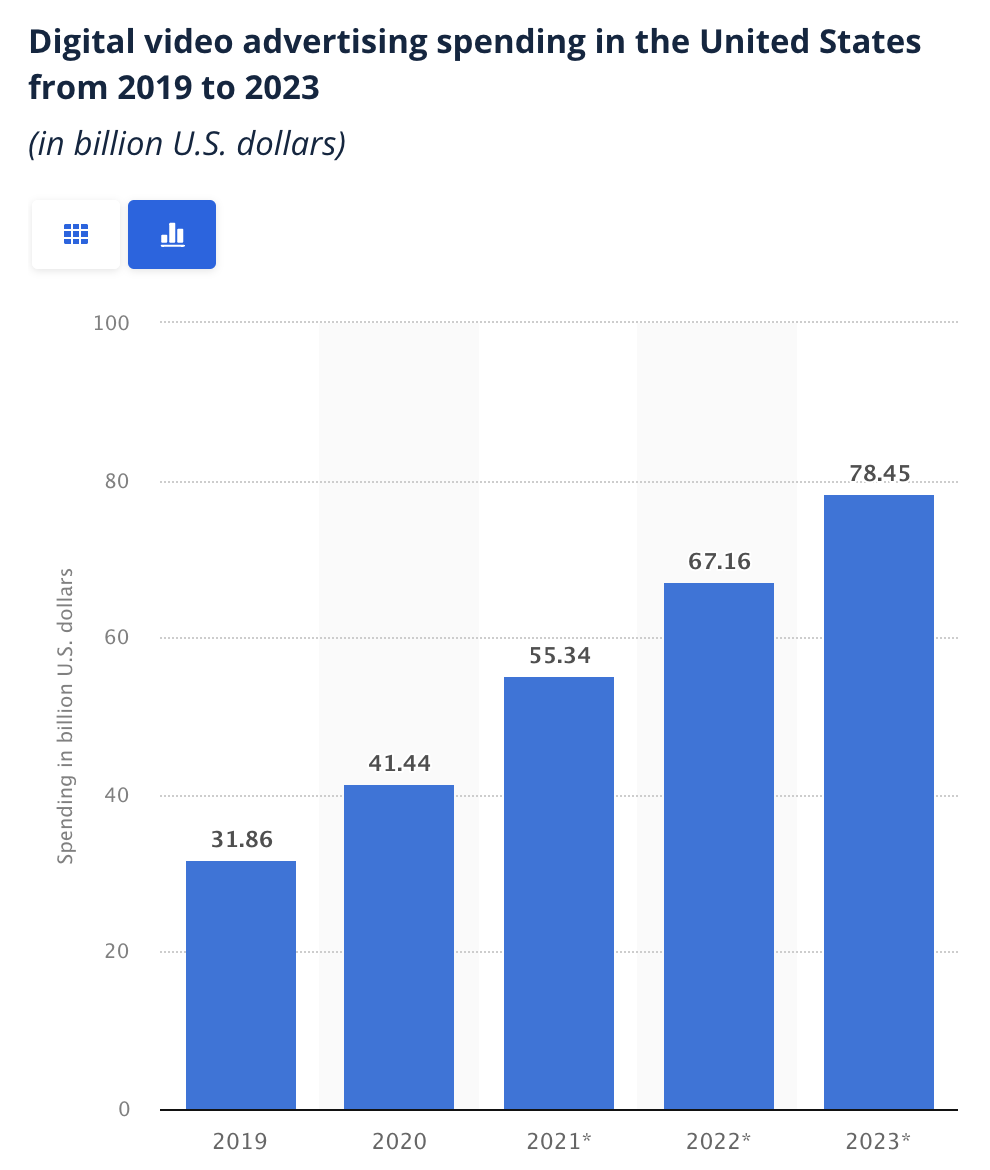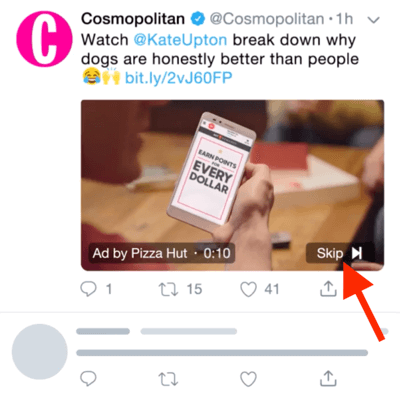A Comprehensive Guide to Boosting Your Marketing Strategy
Social media marketing has really changed the game.
On average, people spend more than two and a half hours on social media each day.
That’s billions – yes, billions – of people scrolling various platforms for over two hours every day.
With that kind of traffic, anyone looking to engage in social media advertising is almost guaranteed to see some level of success.
And, if you play the game right, video ads can become your most prosperous revenue generator across your entire omnichannel strategy.
Video ads have become an indispensable tool for brands seeking to capture the attention of potential customers.
The dynamic nature of video ads makes them more effective than traditional advertising formats, such as static images or plain text.
In this blog post, we’ll dive into the world of video ads, exploring their various types, and examining their role throughout the marketing funnel.
You’ll quickly see why video is key and want to dip your toes into these waters.
Understanding Video Ads?
Once upon a time, companies were encouraged to advertise through imagery.
It was important to upload quality images to all websites, social media accounts, and email marketing campaigns.
Today, imagery has advanced to video.
Short how-tos and other explainer videos are what people want to see.
Consider the amount of time people spend on YouTube watching makeup tutorials, product reviews, and other short episodes.
eCommerce video is a great way to put the spotlight on new products and services in a format that people are likely to consume.
By keeping it short, sweet, colorful, and engaging, it’s possible to garner a host of new leads with one short video.
Definition and types of video ads
Video as promotional content, leverages the power of moving images, sound, and storytelling to communicate a brand’s message.
There are several types of video ads, each with its unique characteristics and use cases:
- In-stream video ads:
These ads appear before (pre-roll), during (mid-roll), or after (post-roll) a video that a user is watching.
They are commonly found on platforms like YouTube and Facebook, and are often used for brand awareness and reach. - Out-stream video ads:
Out-stream video ads play outside the context of a video player, usually embedded within a webpage’s content.
These ads are designed to be less intrusive and provide a better user experience, as they only play when they’re visible on the user’s screen. - In-display video ads:
In-display video ads are standalone ads that appear in search results or alongside related content.
They can be used to drive traffic to a brand’s website or a specific landing page. - In-app video ads:
In-app video ads are displayed within mobile apps and are tailored to the app’s user experience.
They can be used to drive app installs, in-app purchases, or other desired actions.
The role of video ads in the marketing funnel
Video ads play a crucial role at every stage of the marketing funnel, as they can be customized to cater to different objectives and target audiences:
- Awareness stage:
At the top of the funnel, video ads can be used to introduce your brand to new audiences, create buzz around your products, and increase your reach.
Engaging, entertaining, or educational content can help your brand stand out and make a lasting impression. - Consideration stage:
As potential customers progress through the funnel, video ads can be used to provide more in-depth information about your products, showcase testimonials, or address common questions or concerns.
This helps build trust and convinces customers that your product is the right choice. - Conversion stage:
When customers are ready to make a purchase, video ads can be used to highlight promotions, offer limited-time deals, or showcase product features that differentiate your brand from competitors.
These ads can help tip the scales in your favor and drive conversions. - Retention stage:
After a customer has made a purchase, video ads can be used to promote complementary products, share tips and tricks for using your product, or highlight exclusive offers for repeat customers.
This helps foster brand loyalty and encourages repeat business.
Video has become an essential component of any successful eCommerce marketing strategy.
By understanding the different types of video ads and how they can be utilized at each stage of the marketing funnel, you can harness their power to drive growth for your DTC eCommerce brand.
Why Does eCommerce Video Work?
eCommerce video is an effective marketing tool because it has a very high conversion rate.
Anywhere from 64% to 85% of people who watch these videos quickly turn from new leads to actual customers.
It’s also a great SEO marketing tool.
By adding the right alt tag, hashtags, and meta description to your video, you can attract quality leads to your videos.
This can draw in new customers as they’re searching Google for various items and it can work across every social media platform.
By incorporating video into your Facebook, Snapchat, or Pinterest ads, you can reach almost anyone who has an account.
Best of all, your ads can be targeted toward your desired demographic.
eCommerce Video Ads for the Win
Platforms like TikTok are making one thing clear: people love scrolling short videos.
Sure, other platforms like Instagram and Pinterest are still popular for great imagery and text.
But, they’re also branching out and taking on short video snippets.
That’s why Insta stories, IGTV (Instagram TV), and Instagram Reels have skyrocketed.
These are surefire ways to spotlight your eCommerce videos

Creating Compelling Facebook Video Ads
To create Facebook video ads that resonate with your audience and drive results, it’s essential to follow these best practices:
Defining your target audience
Before you start creating your video ad, it’s crucial to define your target audience.
A well-defined audience ensures that your message reaches the right people, leading to higher engagement and conversions.
Consider the following factors when defining your target audience:
- Demographics: Analyze your existing customers and identify common demographic traits, such as age, gender, location, education level, and income.
- Interests: Identify the interests and preferences of your target audience, including hobbies, favorite brands, and the type of content they consume.
- Behaviors: Examine the online and offline behaviors of your target audience, such as their shopping habits, the devices they use, and the social media platforms they frequent.
Facebook’s powerful targeting options allow you to reach your ideal audience based on these factors, ensuring that your video ads are shown to the most relevant users.
Setting clear goals and objectives
Establishing clear goals and objectives is essential for the success of your video ad campaign.
Your goals should align with your overall marketing objectives and should be specific, measurable, achievable, relevant, and time-bound (SMART).
Some common objectives for Facebook video ads include:
- Brand awareness: Increase visibility and reach a wider audience.
- Engagement: Encourage users to like, comment, share, or watch your video.
- Lead generation: Collect contact information from potential customers.
- Sales: Drive purchases on your website or landing page.
By setting clear goals, you can better measure the performance of your video ads and make data-driven optimizations to improve their effectiveness.
What are the most challenging obstacles to video marketing success?
from envato
Crafting a compelling story
A compelling story is at the heart of any successful video ad.
A well-crafted story can evoke emotions, create a connection with your audience, and inspire action.
To create an engaging story for your video ad, consider the following tips:
- Start with a strong hook: Capture your audience’s attention within the first few seconds by presenting a problem, asking a question, or showing something surprising or intriguing.
- Develop a clear narrative: Structure your video around a beginning, middle, and end, guiding your audience through a journey that highlights your brand’s unique selling proposition.
- Showcase your brand’s personality: Use humor, emotion, or a relatable scenario to create a memorable experience that reflects your brand’s identity.
- End on a high note: Conclude your video by resolving the problem or question you presented at the beginning, leaving your audience feeling satisfied and inspired.D. Utilizing high-quality visuals and sound
High-quality visuals and sound are essential for creating an immersive and memorable video ad experience.
Keep the following tips in mind:
- Invest in quality equipment: Use a professional camera or a high-end smartphone to capture crisp, clear visuals, and a quality microphone to record clean audio.
- Pay attention to lighting: Natural light is ideal, but if that’s not possible, use professional lighting equipment to ensure your video looks polished and professional.
- Use on-brand visuals: Incorporate your brand’s colors, fonts, and logo to create a consistent visual identity that reinforces brand recognition.
- Choose the right music: Select a background track that complements your video’s tone and message, while ensuring you have the necessary licensing rights to use it.E. Optimizing video length for different platforms
While Facebook allows video ads to be up to 240 minutes long, shorter videos tend to perform better.
To optimize your video length for maximum impact, consider the following guidelines:
- Feed videos: Aim for 15-30 seconds, as shorter videos have a higher completion rate and keep users engaged.
- Stories: Keep your video ads between 5-15 seconds, as this format is designed for quick, snackable content.
- In-stream ads: Limit your video to 5-15 seconds, since these ads appear during other video content and should not be too disruptive.
- Carousel ads: Aim for 15-30 seconds per video, as users can scroll through multiple videos within a single ad unit.
Keep in mind that your video should be long enough to convey your message effectively, but not so long that users lose interest. Test different video lengths to determine the optimal duration for your target audience and campaign objectives.
Including a clear call-to-action
A clear call-to-action (CTA) is crucial for driving users to take the desired action after watching your video ad.
To create an effective CTA, consider the following tips:
- Make it visible: Ensure that your CTA is prominently displayed within your video, either as an on-screen text overlay, a clickable button, or as part of the video’s end card.
- Keep it simple: Use concise, action-oriented language that clearly communicates the action you want users to take, such as “Shop Now,” “Learn More,” or “Sign Up.”
- Align it with your objectives: Your CTA should be directly related to the goals and objectives you set for your campaign. For example, if your goal is to drive sales, your CTA should lead users to a product page or a landing page with a clear path to purchase.
- Test different CTAs: Experiment with various CTA copy, placement, and design to determine which combination drives the best results for your campaign.
By following these best practices, you can create compelling Facebook video ads that resonate with your target audience.
Effectively communicate your brand’s message across your eCommerce management foundation.
Remember to continually analyze your campaign performance, test new ideas, and optimize your strategy to maximize the impact of your video ads.
Choosing the Right Platforms for Your Video Advertising
Selecting the appropriate platforms for your video advertising efforts is crucial for reaching your target audience and achieving your marketing goals.
Here’s an overview of the most popular platforms and their unique strengths:
YouTube
YouTube is the world’s largest video-sharing platform, with over 2 billion monthly active users.
It’s an excellent choice for brands looking to reach a broad audience through in-stream video ads, display ads, and sponsored content.
YouTube is particularly effective for building brand awareness, driving website traffic, and showcasing product tutorials or demos.
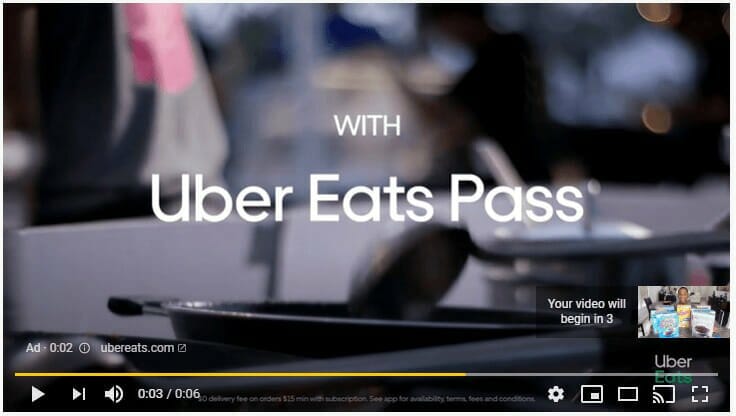
Facebook and Instagram
Facebook and Instagram are powerful platforms for video advertising, offering a variety of ad formats such as in-feed videos, Stories, and in-stream video ads.
Both platforms allow for robust targeting options and are ideal for increasing brand visibility, driving engagement, and generating leads or sales.
Instagram, with its visually-focused interface, is particularly effective for showcasing eye-catching product visuals or lifestyle content.
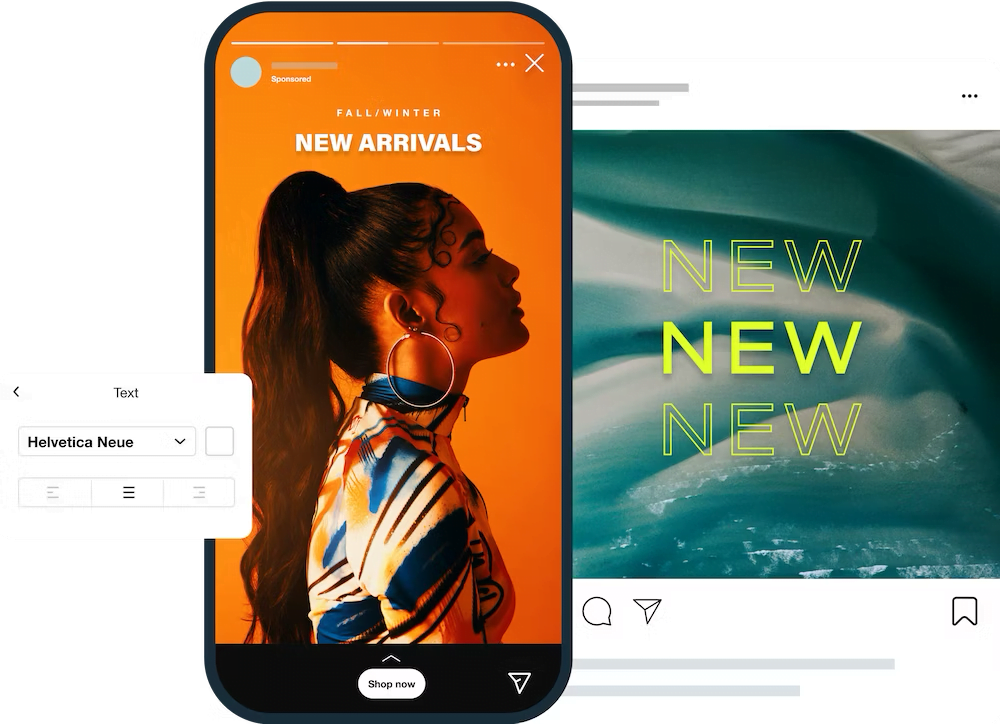
LinkedIn
LinkedIn is a professional networking platform that caters to a more business-oriented audience.
Video ads on LinkedIn are well-suited for B2B marketing, thought leadership content, and recruitment campaigns.
With LinkedIn’s unique targeting options, you can reach users based on their job titles, industries, or company size, ensuring your message resonates with a relevant professional audience.
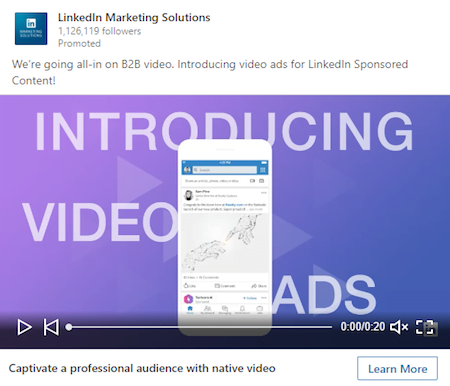
Twitter
Twitter is a fast-paced platform that emphasizes real-time conversation and trending topics.
Video ads on Twitter can be used to join trending discussions, share breaking news, or promote time-sensitive offers.
Twitter’s ad formats include Promoted Video and In-Stream Video Ads, making it a suitable platform for increasing brand awareness and driving website traffic.
Snapchat
Snapchat is a multimedia messaging app popular among younger audiences, with a majority of its users being under the age of 35.
Snapchat offers a range of ad formats, including Snap Ads, Story Ads, and Sponsored Lenses.
The platform’s ephemeral nature encourages spontaneous, authentic content, making it ideal for promoting limited-time offers, behind-the-scenes footage, or influencer collaborations.
TikTok
TikTok is a short-form video platform known for its creative, user-generated content and viral challenges.
Advertising on TikTok allows brands to reach a predominantly Gen Z audience through in-feed video ads, branded hashtag challenges, or sponsored effects.
TikTok is an excellent platform for driving engagement, increasing brand visibility, and fostering user-generated content.
Determining the best platform for your target audience and marketing goals
To choose the right platform(s) for your video advertising campaign, consider the following factors:
- Audience demographics: Identify the platforms most popular among your target audience based on their age, interests, and online behaviors.
- Marketing objectives: Align your platform choice with your campaign goals, such as building brand awareness, driving engagement, or generating leads.
- Budget: Different platforms have varying costs associated with advertising, so consider your budget when selecting the right mix of platforms.
- Content fit: Evaluate which platforms best showcase your video content, considering factors like video length, visual appeal, and storytelling style.
By carefully selecting the right platforms for your video advertising campaign, you can maximize your reach, drive better results, and ensure your message resonates with your target audience.
Measuring the Success of Your Video Ads
To ensure the effectiveness of your video ads and optimize your strategy, it’s crucial to measure and analyze their performance. Here’s how to do it:
Key performance indicators (KPIs) for video ads
Various KPIs can help you assess the success of your video ads.
Some important ones include:
- View-ability and completion rates: These metrics indicate the percentage of users who viewed your video and those who watched it to completion. High view-ability and completion rates suggest that your video is engaging and resonates with your target audience.
- Click-through rates: The click-through rate (CTR) measures the proportion of users who clicked on your video ad to visit your website or landing page. A high CTR indicates that your video ad effectively drives users to take action.
- Conversion rates: Conversion rates show the percentage of users who completed a desired action (e.g., making a purchase or signing up for a newsletter) after viewing your video ad. High conversion rates imply that your video ad successfully drives users toward your marketing goals.
- Engagement metrics (likes, shares, comments): These metrics reflect how users interact with your video ad. High engagement levels signify that your content is shareable, memorable, and appealing to your audience.
Using analytics tools to track video ad performance
Various analytics tools can help you track the performance of your video ads.
Most social media platforms, such as Facebook, Instagram, YouTube, and LinkedIn, offer built-in analytics tools that provide detailed insights into your ad performance.
Additionally, you can use Google Analytics to track user behavior on your website or landing page after they’ve clicked on your video ad.
A/B testing for continuous improvement
A/B testing (also known as split testing) is a valuable method for optimizing your video ad performance.
By creating multiple versions of your video ad with slight variations (e.g., different headlines, visuals, or CTAs), you can test which version performs best and use the insights to inform future campaigns.
Conduct regular A/B tests to continually refine your video ads and maximize their impact.
Adapting your video ad strategy based on data-driven insights
Data-driven insights play a crucial role in shaping and adapting your video ad strategy.
Analyze your KPIs, engagement metrics, and A/B test results to identify trends, strengths, and areas for improvement.
Use this information to optimize your video content, targeting options, and ad placements to enhance your video ad performance continually.
By closely monitoring the success of your video ads, leveraging analytics tools, and adapting your strategy based on data-driven insights, you can ensure that your video advertising campaigns deliver optimal results.
Tips for Maximizing Your Video Ad Budget
Creating and promoting video ads can be a significant investment.
However, with the right strategies, you can maximize your video ad budget and get the most value for your marketing spend.
Here are some tips to help you do just that:
- Leveraging user-generated content:
User-generated content (UGC) is an excellent way to source authentic and engaging video ads without breaking the bank.
Encourage your customers to create and share videos featuring your products or brand experiences.
Not only will UGC save you production costs, but it also adds credibility and social proof to your ads, making them more likely to resonate with your audience. - Repurposing existing content:
Instead of creating new video content from scratch, consider repurposing your existing assets. You can transform blog posts, testimonials, or even social media posts into compelling video ads.
This approach not only saves you time and resources but also ensures that your video ads are aligned with your overall content strategy. - Utilizing cost-effective video production tools:
With a plethora of video production tools available, you don’t need a massive budget to create high-quality video ads.
Tools like InVideo, Adobe Spark, and Canva offer affordable solutions for editing and producing professional-looking video content.
Utilize these tools to create compelling video ads without straining your budget. - Targeting specific audience segments to maximize ROI:
The more targeted your video ads, the higher the likelihood of reaching users who are genuinely interested in your products.
Use the robust targeting options available on most advertising platforms to zero in on specific demographics, interests, or behaviors that align with your ideal customer profile.
By focusing your ad spend on the most relevant audience segments, you can maximize your return on investment (ROI) and get more value from your video ad budget. - Exploring different bidding strategies:
Most advertising platforms offer various bidding options, allowing you to control your ad spend and optimize your campaign performance.
Experiment with different bidding strategies, such as cost-per-click (CPC), cost-per-impression (CPM), or cost-per-action (CPA) to find the most cost-effective approach for your video ad campaigns.
Monitor your campaign performance and adjust your bidding strategy as needed to achieve the best results for your budget.
Implementing these techniques can maximize your video ad budget.
While also creating effective video campaigns that drive growth and success.
Always keep an eye on your campaign performance and be ready to adapt your strategy to ensure you’re making the most of your marketing spend.
Conclusion
The potential of video ads to elevate your marketing strategy
Video has emerged as a powerful tool to engage audiences, tell compelling brand stories, and increase sales for your eCommerce brand.
With the right approach, video can elevate your marketing strategy, helping you stand out from the competition and resonate with your target audience on a deeper level.
The importance of continuous learning and adaptation in the ever-evolving digital marketing landscape
As with any aspect of digital marketing, it’s crucial to stay informed and adapt to the ever-evolving landscape of video advertising.
Platforms, user behaviors, and best practices are continually changing, making it essential for marketers to stay abreast of the latest trends, techniques, and tools.
By embracing continuous learning and remaining agile in your video ad strategy, you can ensure that your campaigns remain relevant, engaging, and effective in driving your desired results.
Encouragement to start experimenting with video ads for facebook to boost your brand’s online presence and drive results
If you haven’t already, now is the perfect time to start experimenting with video ads as part of your eCommerce marketing strategy.
Begin by creating compelling video content that showcases your brand’s unique value proposition, and then leverage the power of various advertising platforms to reach your target audience effectively.
Remember to monitor your campaign performance, learn from your data-driven insights, and continually refine your approach to maximize the impact of your video ads.
In conclusion, video ads offer a vast potential for enhancing your eCommerce marketing efforts, enabling you to connect with your audience in a more engaging and authentic way.
By understanding the fundamentals of video advertising, creating compelling content, choosing the right platforms, measuring success, and optimizing your budget, you can unlock the full potential of video ads to drive growth and success for your brand.
So, take the plunge and start experimenting with video ads today.
With persistence, creativity, and a data-driven approach, you can harness the power of video advertising to boost your brand’s online presence, captivate your audience, and achieve your marketing objectives.

